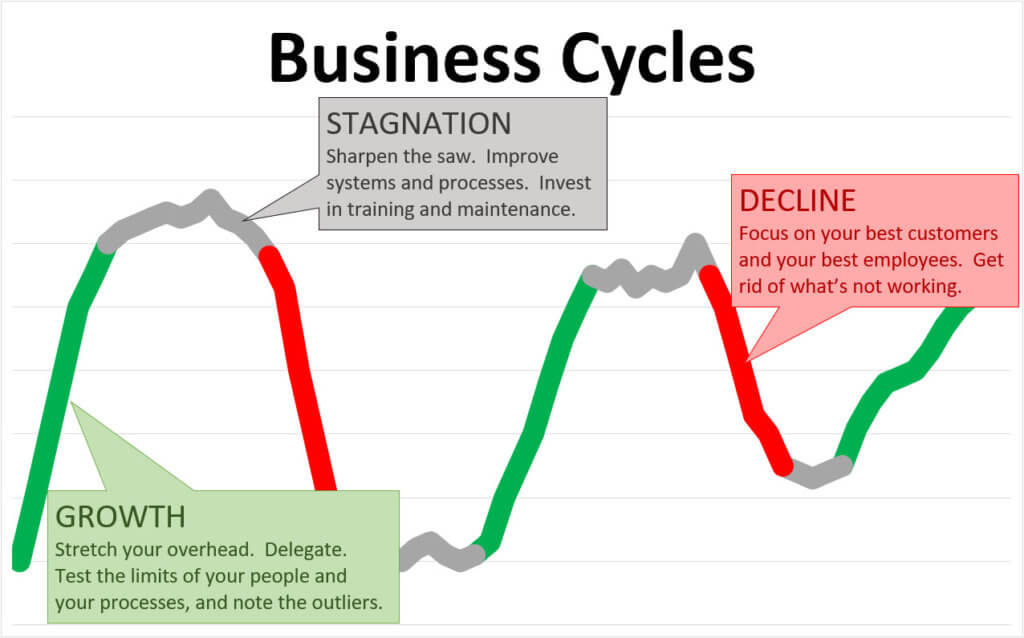The fortunes of weak companies rise and fall with the economy. Great companies use the ebbs and flows of the economy to their advantage.
Beware of Pride
The latest DAT report says dry van truckload rates are at an all-time high after climbing 33% in the past 3 months. This dramatic rate increase has been a lifeline for carriers on the verge of bankruptcy just a few months ago.
In recent conversations with executives, analysts, and bankers, I’m shocked by how many of these nearly bankrupt carriers have leaders taking a victory lap and patting themselves on the back. Do they really think their strategic brilliance is the reason their P&L has improved?
Their core business hasn’t improved – the jump in rates just raised the water level and covered the stumps!

Cycles Build Strong Businesses
On a beautiful sunny day, it’s tempting to think, “I wish it could just be like this all the time.” But that would destroy our planet! If we had beautiful sunny days 24×7 everything would dry out and die! The daily cycles of night and day, and the annual cycles of the 4 seasons are what make beautiful sunny days possible.
I’ve always loved the wisdom of Douglas Malloch’s “Good Timber” poem.
The tree that never had to fight
For sun and sky and air and light,
But stood out in the open plain
And always got its share of rain,
Never became a forest king
But lived and died a scrubby thing….
Good timber does not grow with ease:
The stronger wind, the stronger trees,
The further sky, the greater length,
The more the storm, the more the strength.
By sun and cold, by rain and snow,
In trees and men good timbers grow….

3 Phases of Business Cycles
There are 3 phases of the business cycle:
- Growth: Revenues are growing 15%+
- Decline: Revenues are shrinking 15%+
- Stagnation: Revenues fluctuating up or down a few percentage points
Unique Challenges
Each phase presents its own unique challenges:
- Growth: It’s not all sunshine, rainbows, and unicorns. Many promising companies have been killed by rapid growth. Systems and processes are stretched to the breaking point; management doesn’t have the bandwidth to deal with problems/opportunities; cash is strained by increased capex and new expenses arriving faster than new revenues; new customers and expectations present new challenges; and HR struggles to hire, train, and retain employees.
- Decline: Initially, stress levels and cash flows improve. But then that gives way to cutting overhead, dealing with banks cutting back your lines of credit, and getting aggressive with pricing and chasing less-desirable customers.
- Stagnation: At first, it’s nice to catch your breath and enjoy a “normal” environment. But then organizations tend to get sloppy. Productivity and performance slips, overhead creeps up. Without growing revenues and profits its hard to justify capex and compensation increases. Some restless employees use their extra time to play politics and cause trouble.
Advice
How do smart companies use these cycles to their advantage?
- Growth: When the business is growing, stretch your overhead. Delegate and test the limits of your people and your processes. Find the people and processes that are outliers (performing unusually well or unusually poorly) and use this information later when deciding what to water and what to weed.
- Decline: When business is declining, focus on your best customers and your best employees. Use your burning platform to get rid of what’s not working.
- Stagnation: When business is stagnant, sharpen the saw. This is the best time to invest – your leaders have bandwidth and you’re not worried about falling off a financial cliff. Improve systems and processes. Invest in training and maintenance. Learn from the wisdom of George Bacon when he said, “Fortunes are not made in the boom times…That is merely the collection period. Fortunes are made in depressions or lean times when the wise man overhauls his mind, his methods, his resources, and gets in training for the race to come.“

Leadership Challenges
The two biggest challenges leaders face when dealing with business cycles are:
- Stuck in the last cycle: Leaders drag their feet reacting to the current cycle because they’re still reacting to the last cycle. For example, they’re reluctant to add overhead because they remember how painful it was to reduce it during the last downturn. Or, they’re reluctant to right size the business because they remember how hard it was to hire good people during the previous growth phase. The best way to counteract this is to have strong outside voices you respect (on your board and/or as advisers) who have the wisdom of experience and who will talk straight with you and challenge your thinking. Remember the wise words of Wayne Gretzky, “Skate to where the puck is going, not where it has been.”
- Forecasting Failures: Yogi Berra said, “It’s tough to make predictions, especially about the future.” He’s right! It is tough! But that’s no excuse to stick your head in the ground and neglect your responsibility. Identify some internal and external indicators you can focus on to see where the market is at and where it’s headed. Do “scenario planning” developing plans for what you will do in different scenarios. Set up some “tripwires” that will trigger when you implement your plans.

The Wise Uber Driver
Picture two Uber drivers in the same city with the same goal of making $1,000/week.
Driver 1 works 5 days a week and never comes home until he’s earned $200 for the day. He works the same territory every day. On busy days, he can go home after just a few hours; but on slow days, he works 15 hours.
Driver 2 takes a different approach. On busy days with back-to-back rides and surge pricing, he works a 10-hour day and makes $500. On slow days, he logs off and uses the extra time to wash his car, get the oil changed, study the app and talk to other drivers to learn where the customers are. If it makes sense, he goes to a different area. If today’s just not a good day to be an Uber driver, he logs off and spends the rest of the day with his family at the beach or at the movies.
Which driver do you think is more successful? Not just financially, but also professionally? Are you more like Driver 1 or Driver 2?
Be Proactive
Be the master of your fate, the captain of your soul! Don’t be the ship drifting at sea hoping the wind and waves will take you where you want to go. Be proactive! Use your sail and your oars and your rudder to get where you want to go. Always be experimenting, observing, and learning. You can do it!

